Teeth: Brushing up on Dentistry
This week, Chris Smith and Izzie Clarke are filling the gaps in our knowledge of teeth; we also meet the microbes in our mouths and test the battle of the toothbrushes; electric versus traditional. Plus, in the news, researchers grow new spinal discs in a dish, we explore the ghostly galaxy next door, and scientists discover one of the largest, oldest structures on the planet.
In this episode
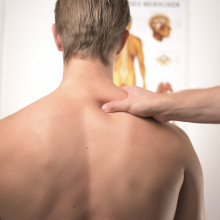
00:53 - Scientists grow new spinal discs
Scientists grow new spinal discs
with Robert Mauck, University of Pennsylvania
About one person in five suffers with a bad back, and a common culprit is wear and tear to the intervertebral discs that sit between the vertebrae that make up the backbone. These discs act as fleshy shock absorbers; they have a soft, jelly-like interior and a tough, elastic outer surface. But, as we age, they stiffen, shrink and deform, and can press painfully on nearby nerves. Artificial plastic and metal replacement discs are available, but these can also wear out, so scientists at the University of Pennsylvania have been exploring how to grow new spinal discs, in a dish. Georgia Mills heard how from Rob Mauck.
Rob - So the central premise of this therapy compared to what's available now, is that this is a living implant. It's an implant that will be made of a patient’s own cells and because the cells are there the cells will be doing what cells in muscular skeletal tissues do and that is continuously making new material and repairing damage and so our hope is that unlike metal and plastic implants, this will be a sort of self-sustaining biologic implant, as durable as your original living intervertebral disc.
Georgia - Right, so these squishy bits between the bones of the spine. You wanted to sort of create them from scratch?
Rob - Precisely.
Georgia - How did you go about doing that?
Rob - Essentially what we do is combine various elements together to create what we call a composite disc structure. And the way that goes about is we produce bio materials that represent the different substructures of the normal intervertebral disc. These are materials that are based on hydrogels - sort of water swollen, networks sort of like jello. And that makes up the inner part of the country like that we've created. And then an outer part which is sort of a tough almost rubber band like structure that surrounds the gelatinous interior portion. Both of these materials were seeded with cells we use mesenchymal stem cells which can be harvested from adults and we grow these in the laboratory for a period of time until they start to take on characteristics of the native tissue.
Georgia - How do you make sure it gets to be the right size and shape?
Rob - So we realized that this is a big challenge to create such a large structure. So we started small and we started actually making these on a scale of a rat disc, just a couple millimeters in height and maybe five millimeters in diameter.
So we optimized all of that in a size that was a suitable for a small animal the rat, and we spent some time then evaluating it once we implanted it into a rat. After that we thought this is promising. Let's see what we can do with bigger length scales that would be more clinically relevant.
We next went to the goat cervical spine so the neck of a goat essentially, and we started building constructs that were designed to function at that length scale. So we started building bigger and bigger discs and growing those in culture in the laboratory. We got to the point where we were pretty happy with what we could produce in the laboratory, and so what we've done recently is actually started testing those in a large animal model in this model.
Georgia - Right so you've actually been putting these discs in to a living goat?
Rob - That's right yes. For the last couple of years we've actually been evaluating how these lab grown living intervertebral discs function, when we put them into a goat cervical spine.
Georgia - Right. And then after the discs have been put in, how did you work out how effective they were?
Rob - The main goal and the main function of the disc is mechanical. The cervical spine supports your head as you turn your head to the left or the right and the first thing we did was after a period of time of implantation, we asked how mechanically robust these tissues? Are maturing further after we implant them? Do they have the appropriate mechanical properties? So we compared their mechanical properties to the mechanical properties of a normal native goat disc?
Georgia - Did you get a goat to do yoga then?
Rob - No but we actually do have little motion sensors that were attached to their horns so that we can see how many times they move their heads around them and things like that.
Georgia - Right so if you've got a stiff necked goat it would come up on the sensors that it's not doing as good. So how did it compare?
Rob - It actually compared quite favorably. So when we measured the properties of these goat discs and compared them to the implanted ones after a period of about two months they actually matched or exceeded the native tissue properties and so we were quite excited about that.
Georgia - Oh wow. Do you think this could move into humans, an animal that walks about on two legs instead of four?
Rob - No absolutely and in fact we chose the goat because - if you ever seen a goat - they have a fairly upright posture and they're very inquisitive animals. They use their heads a lot. They obviously run into each other and butt heads but they have an upright posture. So they use their necks in a manner very similar to how humans use their cervical spines as well.
And in fact as we've been getting this data, Harvey Smith my clinician colleague and I and Sarah Gullbrand who is another participant in the study have been talking about well what really is the next step? For us the next step let's start talking to the FDA the Food Drug Administration here in the U.S. about what it will take to transition this into phase One clinical trials in humans.
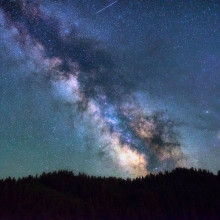
06:12 - Cannibal galaxies and dark matter hurricanes
Cannibal galaxies and dark matter hurricanes
with Wyn Evans, Institute of Astronomy at Cambridge University
The “GAIA” space observatory craft was launched by the European Space Agency in 2013. Since then it’s been scanning the skies with a 1 billion pixel camera. The aim is to image millions of stars in our Milky Way galaxy to understand how our cosmic neighbourhood has evolved and how it behaves. Cambridge Institute of Astronomy researcher Wyn Evans is one of the scientists working on the project and joined Chris Smith in the studio.
Wyn - We've known the galaxy is a messy eater for some time but this is the latest example of its guzzlings. The galaxy is called Antlia 2 but we call it a feeble giant - it’s feeble because it's got very few stars, but it's a giant because it's very extended. It's the least concentrated galaxy that we know.
Chris - Now what observations has Gaia made that enable you to know that our Milky Way galaxy ate this other entity back in history? And when did that happen?
Wyn - Gaia is providing precise positions and velocities of billions of stars in our galaxy. We look for stars that are moving in a coherent way, different from the normal pattern of rotation of stars in the Milky Way disk. That is how we found Antlia 2 and that collision happened billions of years ago.
Chris - In other words we've got this cloud, for want of a better word, of stars which are doing their own thing and you can see that they're moving in a trajectory that's slightly different than what we can really see as native stars to the Milky Way. And so that tells you that those have obviously come in with their own agenda, their own direction, movement, velocity, and that's how you could pick them out and tell that they've been eaten?
Wyn - That's exactly it. The galaxy is a busy place and there are lots of stars doing lots of things. We're trying to pick out stars that are having a particular dance - a particular way of moving.
Chris - Now in its early history how would the Milky Way have ended up encountering this other galaxy that it then ended up consuming?
Wyn - The Milky Way is a big galaxy, it's a heavy eater, so it pulls in smaller galaxies by its gravitational pull. Antlia 2 or the feeble giant was just unlucky and fell into the gravitational field of the Milky Way Galaxy and was gradually eaten and pulled apart.
Chris - And the stars that have been incorporated - do they now begin to adopt the same paths as the stars that are native to the Milky Way? Or will they continue on some bizarre trajectory and eventually leave again, or have they been captured indefinitely?
Wyn - They are still intact at the moment but, as the feeble giant falls towards the centre of the Milky Way, it will increasingly be torn apart and these storms will form part of that diffuse corona around the Milky Way called the stellar halo.
Chris - Now when you look at those stars I presume that one of the other things you can do is to is to tell quite a lot about them in terms of their size, how developed, how old they are and what they're burning and how fast. And so that tells you a bit about the history of the galaxy they came from. So what is their history?
Wyn - We can indeed do that. We can with spectroscopy measure the metallicity of these stars, which tells us something about the chemical history of the galaxy. It's harder to get ages of stars, that's really tough. So we know that the galaxy is very metal poor, so we do know that it was formed a long time ago - shortly after the Big Bang.
Chris - Okay well that's interesting. And so this tells us obviously a bit about the patch of space that these galaxies were in, and how they were formed, and what that was sort of like. What the arrangements must have been like in the early period of the universe then.
Wyn - Indeed these are fossils, if you like, akin to the kind of fossils that we find in rocks on the earth. They're telling us the conditions at the very early universe.
Chris - And do they actually fit with our models? Because obviously scientists like yourself are designing models of how the universe formed and evolved and is continuing to evolve. And those are only theories - you've got to then apply data like these that you've collected, in order to test those theories. So does it look like our models of the early universe are right?
Wyn - Well Antlia 2 is a very unusual galaxy and at present we can't fully explain it. It is so diffuse that the backbone of the galaxy, which is formed by the dark matter, must have what is called core - so as to protect the stars and enable them to remain intact and that is not currently predicted by our theories of galaxy formation.
Chris - Oh good because that gives you something to go after now doesn't it! Because if it all fitted all the theories life would be pretty boring.
Wyn - That's always the case with new data!
Chris - Now you mentioned dark matter. I started on that point because your colleagues are now saying the other thing that Gaia is detecting evidence for, possibly, is a hurricane of dark matter coming through. What's dark matter and why's there a hurricane of it passing through our cosmic neighborhood?
Wyn - Well dark matter forms the backbone of galaxies. It's probably some form of elementary particle and there's abundant astronomical evidence for its existence, but there's no direct detection of this mysterious particle. What we've done is we've discovered a stellar stream. And that itself is part of the disgorging of an earlier galaxy - it's a galactic meal, the remnants of an earlier effect of galactic cannibalism. So the stream is passing through the solar neighborhood and it's accompanied by a stream of dark matter.
Now that sounds rather terrifying but the interaction of the dark matter particles with ourselves is very low, so we can go about our daily lives drinking coffee, having toast, without any ill effects. But this will have an important consequence for direct dark matter detection experiments which are normally deep underground and are looking for tiny recoils.
Chris - And how will this help you to to try and fathom out what dark matter is?
Wyn - Well the stream is hitting the solar system head on. So there's a very large relative velocity between the sun, the earth, and these dark matter particles - so that will predict a large number of very high velocity recoil events in these direct dark matter detection experiments. So this is a precise signal that can now be sought in these experiments and if it is indeed fine, that is very convincing evidence for the existence of dark matter.

12:35 - MYTH: Pterodactyls are dinosaurs
MYTH: Pterodactyls are dinosaurs
with Georgia Mills
It’s mythconception time, and Georgia Mills has been ruffling her feathers about this claim…
Georgia - If you’re anything like me, a disproportionate amount of time is spent discussing which dinosaurs were the coolest. Was it the mighty tyrannosaur? The armoured ankylosaurus? Or the fabulously feathered archaeopteryx? Although, on occasion, someone might unwittingly chip in that their favourite dinosaur was a pterodactyl. To which, for the paleontological pedant, there is only one response.
No. Pterodactyls are not your favourite dinosaur, because pterodactyls are not dinosaurs. The offender then gets an unexpected and unwanted lecture in reptile evolution.
The story explaining just why they are wrong starts just over 300 million years ago when the ancestors of all modern reptiles and birds first appeared. Just like the Beatles, they couldn’t stay in one group forever, and broke up, or speciated. Like branches on a tree, different styles of reptile start appearing, changing, and then splitting up again - all over millions of years.
One of the branches that broke off contain the ancestors of all modern lizards and snakes. While another got busy becoming crocodiles – who have remained virtually unchanged since before the start of the Jurassic. Evolution obviously adheres to the old adage - if it ain’t broke, don’t fix it.
Then, still before the dinosaurs begin, another branch of reptiles diverges. And this group did something a little unusual: their front limbs turned, over time, into wings and they took to the skies. They became the group known as the pterosaurs. The ancestors of all pterosaurs split off from this evolutionary tree before the dinosaurs came to be, so while they ruled the skies at the same time as dinosaurs ruled the land, they shouldn’t be called dinosaurs anymore than bats should be called cows.
Another group that are frequently mistaken for dinosaurs are the ichthyosaurs and plesiosaurs. These amazing reptiles found their way back into the oceans and while they were terrifying marine predators, dinosaurs they were not.
So how do we know? The clue to how the family tree is laid out lies in the fossil record and for dinosaurs there are a few characteristics in their skeletons that every single member will have – from the long necked diplodocuses to the tiny feathered velociraptor.
These features include backwards facing shoulder blade, a hole in the hip socket and holding limbs directly under the body. Pterosaurs and marine reptiles just don’t have that many of the same characteristics, so we know that they’re not from the same group.
If the pterodactyl-loving offender can cope with any more correcting, you might also want to let them know there’s technically no such thing as a pterodactyl anyway, it’s an outdated term and they’re now known as pterosaurs.
So that’s why pterodactyls don’t qualify as dinosaurs or indeed anything. And it's also the reason paleontologists don't get invited to many parties.
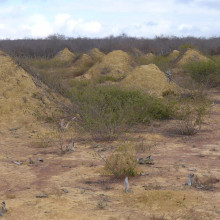
The oldest, biggest structure on Earth
with Stephen Martin, University of Salford
When we think of the ancient wonders of the world, Egyptian pyramids or ancient constructions like Stonehenge often spring to mind. But this week scientists announced the discovery of one of the largest, oldest structures on the planet; it’s the same size as Great Britain. But, incredibly, it wasn’t built by humans - something much smaller did this. And Eva Higginbotham heard what from Salford University’s Stephen Martin who initially went looking for something quite different...
Stephen - So we were in Brazil collecting bees and suddenly these mounds started to appear and they're incredibly numerous and they're everywhere. Normally with termites, they're constructed of soil and saliva but in the Brazilian population that we've studied they're just waste. They're tunneling underground, making huge tunnels, a massive network and they have to get rid of the soil somewhere just like miners. And so miners build slag heaps of waste stone and so the termites have done the same thing with soil and they've just deposited all the soil above ground.
Eva - How big are these mounds and how much space do they take up? How big an area are we talking?
Stephen - First of all there are about two to four metres high and they're about nine meters across. So they are large. There is a mound about every 20 meters. In fact they're incredibly numerous. There are millions of mounds all in one area. The total area we’ve estimated that they cover is about the size of Great Britain, which is a vast area for any species to build anything.
Eva - Amazing! How have we managed to miss these mounds so far? How can it be 2018 and we've only just found this area the size of Great Britain?
Stephen - Well, they’re hard to miss if you're in the area. The reason they haven't been found is that they live within the forest, because the forest produces the dead leaves which is what they feed off. The forest is just slightly higher than the mounds. And so even when the leaves have gone, the forest is so dense and thorny. You can't actually see the mounds. It's just been one of these things where there are very large areas still on this planet where scientist don’t go and study.
Eva - And so what's so special about these mounds.
Stephen - What's special is the insects still live underneath the mounds in the ground and the mounds are about 4000 years old. We think we’re the dominant life force on the planet, in fact we’re not. The biomass social insects, that’s ants and termites and some bees and wasps, are actually far greater than all of vertebrates. Dogs, cats, people, elephants. The big difference is you never get to see them because most of them live in the ground or up in the trees. And here is a really stark example of the activities of a social insect that lives in the ground but you can see their activities above it. And as people we've never created a single structure or city anywhere near the size of these. So they're a very dominant force. The social insects have been here long before we have and they'll probably be still be here long after we are gone.

19:17 - The London Underground Mosquito
The London Underground Mosquito
with Menno Schilthausen
If you wanted to go on a journey into the wonderful world of evolution, the London Underground might seem an unlikely place to start. But the tube tunnels have given rise to a surprising evolutionary connection that has nothing to do with trains: because the Underground has its own species of mosquito. Genetically distinct from its above-ground relative, the London Underground mosquito was first documented anecdotally during the Second World War. This story has inspired a new book called “Darwin Comes To Town – how the urban jungle drives evolution”. Francesca Fazey took a trip on London Transport to speak to the author, evolutionary biologist Menno Schilthausen...
Francesca - Nature gets into every gap. Even here, in the tube’s dark tunnels filled with smoke and grime and rushing commuters, evolution is at work. During the Second World War, London's residents used many of the tube line tunnels as makeshift air raid shelters hiding out with their families as the bombs rained down on their city. But many stories of the horror of this experience were punctuated with mention of an added menace: A particularly aggressive mosquito the likes of which the families had not been used to in their lives on the surface. Few people paid attention to these accounts but in the 1990s a research team found that there was truth to the stories of a sinister underground mosquito.
Menno - The scientific name is Culex molestus, or sometimes people say Culex pipiens molestus, so so they say it's a subspecies of the regular mosquito, Culex pipiens, but it is actually quite different so I prefer to call it a separate species.
Francesca - Menno Schilthausen is an evolutionary biologist at the National Natural History Museum in the Netherlands.
Menno - It is different from its closest relative, you could say the aboveground mosquito, in three ways. The underground mosquito prefers to bite humans instead of birds, which the aboveground mosquito does. The underground mosquito does not mate in these large mating swarms that you see above ground, the underground mosquito really mates one on one in very confined spaces, and also the underground mosquito does not need a blood meal before it can lay eggs, which the aboveground mosquito does need. So you have three fundamentally different aspects of this of its life history that have evolved away from the ancestor which was the aboveground mosquito.
Francesca - In the short time in which humans had developed tunnels and begun inhabiting underground spaces a whole new species had evolved.
Menno - One of the cool things I think is that in the London Underground these mosquitoes have not only evolved away from their ancestors aboveground but also mosquitoes in different underground lines are genetically different from each other because they are sort of separated and live in different worlds. And so those mosquitoes in the Circle Line are genetically a little bit different from the ones in the Piccadilly Line for example.
Francesca - Like most biologists he grew up loving the great outdoors as far away from the effects of people as he could get. But unlike many others his passion for evolution and studying natural selection has steered him back towards the cranes and cars of the concrete jungle. So much so in fact that he has written a book in which he outlines the amazing ways that nature adapts right in front of us in urban environments.
Menno - In cities, evolution goes really really fast so you can actually watch evolution take place over a time span of decades, sometimes even years, and that makes evolution really tangible and I think that's a really good way to show that evolution is a very mundane process really, you don't need to study fossils you don't need to go to the Galapagos to see it happening, it's happening everywhere all the time including in your own street and in your own backyard.
Francesca - Menno’s favorite example of urban evolution, he tells me, is the city blackbird which was the first bird to colonise cities in Europe and now shows multiple changes from its forest ancestor.
Menno - The city blackbirds have shorter beaks, in some cities they also have shorter intestines. They don't migrate anymore, the forest blackbirds, which still exist of course, they do migrate away during the winter, the urban blackbirds don't.
Francesca - But when is adaptation evolution and when is it just learning. Take the famous example of bluetits in the UK who learned to peck open the milk bottles left outside people's front doors. That was learned behavior. When would it represent an evolutionary shift. Well it depends on whether genetics are involved.
Menno - Of course there's not a gene for opening the caps of milk bottles but there are genes for inventiveness for something called neophillia. So so being curious about new things and also for tolerance towards humans. Those are all things which have a genetic basis.
Francesca - Since 2007 more than half of the world's human population have lived in urban environments. And by 2030 it's believed that a full 10 per cent of land on Earth will be covered by a city of some sort.
Menno - Whether we like it or not the world at the moment is in a situation that is unprecedented. We've never before had a situation where a single species - namely humans - is affecting the ecosystems of the world everywhere, and in such a drastic way. Again whether we like it or not we are witnessing a very important, unprecedented crucial change in the history of life on Earth and we should be studying that. Right now humans are one of the most important evolutionary forces and we should really take that into account.
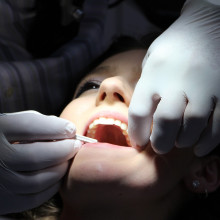
What are teeth?
with Nick Williams, Devonshire House Dental Practice
Open your mind and mouth wide. Chris Smith was joined by dentist Nick Williams, from Devonshire House Dental Practice in Cambridge, to chow down the science of teeth plus we put intern, Eva Higginbotham, to the dental test. But first up, what exactly are teeth?
Nick - We adults have about 32 teeth in our mouths and they're made up of enamel, which is the hard outer layer, which is about 97 percent mineral -that's the white bit. Dentine in the middle layer which is about 70 percent mineral. And then you have the nerve and blood supply in the middle of the tooth called the pulp and that has extensions of the nerves - it extends into the dentine. And when you get sensitive teeth often that's because the dentine is exposed there.
Chris - When you say the dentine is 70 percent mineral, what do you mean by mineral and what's the other 30 percent then?
Nick - So it's mineral in terms of crystal called hydroxyapatite and there's much more of that in the enamel which makes it harder. It's a similar matrix to bone. And then the other bit is made up of collagen and in other extensions of the nerve and blood supply, so it’s quite a tubular structure.
Chris - And the hydroxyapatite's the stuff that makes the enamel tough and hard. And when we put fluoride in toothpaste that gives it additional strength doesn't it? How does it do that?
Nick - It does indeed. So if you have sugar in your diet the bacteria feed off the sugar and that actually can take mineral out of the teeth, making it more porous. That's the start of tooth decay and fluoride in toothpaste helps to remineralise the tooth so it can actually reverse the harmful effects of that decay.
Chris - How does it actually do that though, how does it get onto the enamel and do something?
Nick - If you remember your periodic table it's on the right hand side. It's quite a reactive element. Instead of hydroxyapatite you have hydroxyfluorapatite which is actually a bigger crystal and that's actually more resistant to that erosion in there.
Chris - Because it's added to drinking water isn't it, fluoride? And also toothpaste. And is the amount in drinking water sufficient to actually protect teeth?
Nick - That's a great question. It depends where you are in the country. It's a naturally occurring element, it's often quite a controversial subject water fluoridation. In fact the Center for Disease Control in America named it as one of the biggest breakthroughs in science and healthcare in the 20th century for protecting teeth because it's getting a frequent application of that fluoride onto the teeth just by drinking that water with the fluoride in it.
Chris - And that's clinically proven is it? I know that’s the language that the adverts love to use but like it's clinically proven that that fluoride does protect if it does strengthen teeth?
Nick - Yeah. Unequivocally, thousands of studies prove it and it's one part per million so it doesn't have to be very concentrated. And you’ll be pleased to know that in Cambridge the Cambridge water authority actually do add to the water to actually get that ideal concentration.
Chris - And apart from fluoride in toothpaste, what else is in toothpaste that helps us to clean teeth?
Nick - So I suppose in a nutshell just a foaming agent!
Chris - Is that to show it works?
Nick - That just helps helps the foaming and helping the fluoride actually get onto the teeth. And interestingly a top tip is after you finish brushing just spit out, don’t rinse off, because that fluoride will actually stay on the teeth.
Chris - Yes well a dental colleague of mine said you know lots of people go swish swish swish before they go to bed and it's the worst thing you can do. Because actually leaving some of that stuff sticking to your teeth - because there’s also a sort of sticky agent in the material that's in toothpaste isn't there that makes it more sticky - and they said, you know, plonk it on your teeth before you go to bed and leave it on because it will help to strengthen teeth overnight.
Nick - Definitely and if you’ve got sensitive teeth as well, you can apply sensitive toothpaste on the neck of the tooth and that will help to reduce that sensitivity.
Chris - Now in terms of actually cleaning physically using toothpaste, what's best in the battle of the brush? Is it electric or traditional manual toothbrush? What's the best way to clean teeth?
Nick - I would tend to recommend electric toothbrush over manual brushing. The aim of the game is still the same but results are generally better with the electric toothbrush. And actually we're going to run a little test here aren’t we?
Chris - Yes, well and we’ve found you a victim. Hello Eva, welcome
Eva - Hello!
Chris - Eva is our Naked Scientists intern at the moment. She’s actually a PhD student studying how the brain develops so we thought actually she put her mouth where her money is this week! So tell us what you've done in the name of science today?
Eva - So today I have not brushed my teeth or used mouthwash or any other agent like that. I brushed my teeth last night and then I haven't brushed this morning or any other point during the day.
Chris - So every dentist listening to this is now shuddering Nick. This is all in the name of science. So you've also eaten a disclosing tablet that will show us where the muck is.
Eva - Yes, I have yeah. I just chewed that up a few minutes ago.
Chris - And this binds to plaque, which is the stuff that coats your teeth and shows where the bacteria are. So Eva now has a blue mouth. Nick so what do you want her to do?
Nick - Excellent well - it's a really helpful sort of visual aid to help with brushing and it’s something we use a lot to help with patients. So what I'll do is if you can split your mouth into left and right, and if you brush your right hand side with your manual toothbrush then the left hand side with the electric toothbrush and then we'll see what the results are.
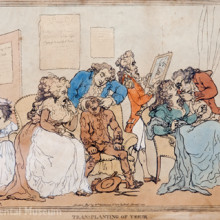
30:34 - Horrible history of Dentistry
Horrible history of Dentistry
with Rachel Bairsto, The British Dental Association
Some of us don’t particularly enjoy a trip to the dentist but if you’d lived a few hundred years ago could be a lot worse. Izzie Clarke paid a visit to the British Dental Association museum in London where curator Rachel Bairsto took her through the gruesome history of dentistry…
Rachel - The dentist didn't come about until about 1728. Before then anybody could give you advice about your teeth or take your teeth out if that was necessary. Perhaps you would go and see the blacksmith if you were in a poor rural community to have your teeth out, perhaps you would consult the barber surgeon who would also cut your beard as well as extract your teeth.
Izzie - I saw a postcard here at the museum earlier that had jester surrounded by a crowd and some poor man waiting to have his tooth pulled out. Was it quite I guess a form of entertainment almost?
Rachel - Well I think it could be certainly there wasn't a dentist if you like, they would be this travelling teeth drawer who would come into town drum up trade. He's looking for somebody who's had a toothache and he's going to a rickety stage in the centre of town and he's going to whip up the crowd. They're all excited and he's going to get to it and he's going to wave it around and perhaps he's going to pull a maggot out of his pocket and say this is what's been causing your toothache because you know it was thought that a tooth worm living in the tooth was the reason for tooth decay it would be this great market place spectacle.
Izzie - Think of it as an old Netflix of the 1720s. This entertaining extraction was certainly a last resort for the patient in question, but what do you expect from an era where oral hygiene wasn't a thing? And it wasn't just the poorer communities that were suffering with extreme tooth decay. Let's fast forward a few decades where the wealthy were eating more and more sugar.
Rachel - Well once you'd had your teeth extracted, perhaps you'd like to buy somebody else's teeth. So the practice of transplanting teeth in the 1780s was quite a fashion and rich people would buy the teeth of poor people who were willing to sell them for their money and literally planted from one mouth to the other. It didn't work as you might expect, but nonetheless it's been immortalized in a Thomas Rowlandson cartoon from 1787 so it's a great record of that procedure. But if transplanting didn't work the next thing that you would probably try is buying an ivory denture. So this is a hippopotamus or walrus ivory denture beautifully carved, great skill involved in this but there was no real accurate way of measuring the mouth so it was pretty much one size fits all.
Izzie - Rachel showed me a pair of these ivory dentures, the gums were carved from white ivory and whilst replacement teeth were also traditionally made from ivory they didn't always look natural, and so people started pinching teeth from dead soldiers on battlefields or took them from dug up corpses - a lucrative business - but of course contamination was a big problem.
Rachel - No they wouldn't last, you’re putting them into what in effect is a pretty putrid mouth. So they're going to rot. They're going to stink. It would be quite horrible.
Izzie - And you thought morning breath was bad! But then things started to change.
Rachel - By the 1850s, we have a revolutionary product that comes in it's called vulcanite and it's a pink rubber. It came from America in the 1850s. It was cheap. It's much more easy for the dentist to make a set of dentures out of these. You would attach porcelain teeth that they've now got into that denture, it’s cooked and it makes it hard, much more aesthetically pleasing and a set of these is going to last you for your lifetime now.
Izzie - So much so that people would have them as wedding presents. But who was the dentist in question? Were people still using their local blacksmith?
Rachel - So the first qualification comes in in the 1860s so we see in 1860 the LDS the Licence in Dental Surgery, obviously as a result of that the students have to learn somewhere, so that the establishment of the dental hospitals and the dental hospital schools. So you're beginning to get the basis of a profession. You've got all this equipment that's coming in in the Victorian period. All these manufacturers are starting to make the equipment that the profession needs. So that's really really helping, you've got a much more scientific understanding coming on so it really is a boon time for the dental profession.
Izzie - We've got improved dentures, porcelain teeth, and finally the much loved dentist drill was invented by a James Morrison in 1878 to prepare teeth for gold fillings.
Rachel - You could achieve 2000 rotations in minutes so dentists have a very strong right thigh of this generation. Shall we give it a go?
Izzie - Yeah! So basically there's a foot pump that spins this mechanic around which goes up this massive rod and then is attached to a drill which has a little mechanism at the bottom which just spins round and round and round and this is the drill that would eventually get into people's cavities, look at what's going on there?
Rachel - Yes so he saw his mother using a sewing machine and he said I can use that for dentistry. I've certainly heard that in Guy's Hospital in the 1970s when there were power cuts if they were in the middle of treatment and there was no electricity, this piece of kit would come out of the cupboard so in order that they could finish it off. And you can control the drill speed making it a pretty fine piece of kit really.
Izzie - But what about oral hygiene? Were people cleaning their teeth to almost prevent the need for these?
Rachel - There's one idea that actually soldiers returning from the first world war brought back with them the toothbrush that they had been issued. Arguably they hadn’t used it to clean their teeth during the war they are using clean their boots, but nonetheless it was a toothbrush. It begins with this idea of having your toothbrush in the family that actually the idea of cleaning your teeth. It's beginning to take root.
It's going to take a long time, but actually you've got the founding of school dental society you've got children's toothbrush clubs, all things that are set up to try and enable people to buy a toothbrush to bring it into this concept of the home and to clean your teeth once a day. We haven't got to twice a yet, but once a day it's a starting point and actually the importance of oral hygiene that you can do something yourself as a patient.
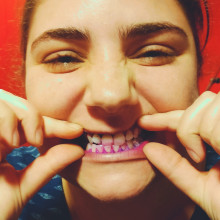
37:48 - Battle of the brushes: Electric vs Manual Toothbrush
Battle of the brushes: Electric vs Manual Toothbrush
with Nick Williams, Devonshire House Dental Practice
Chris Smith left intern Eva Higginbotham brushing away the dye from a disclosing tablet, something that highlights all the plaque that builds up on teeth between brushings. She used an electric toothbrush to clean one half of her mouth and a manual toothbrush for the other side. But which is better? Dentist Nick Williams helped explained the results...
Nick - First of all I can see Eva has done a very good job, certainly better than a lot of teenagers that I see, and the left side where you see electric toothbrush it's worked perfectly. That's lovely and clean. The right hand side with the manual brush is just a little bit of the red stain along the gum line still and a little bit between the teeth, which is where the electric toothbrush is more effective at getting rid of that.
Chris - Does that tend to be normally the sort of danger area then, it's along the gum line, which is where we characteristically miss with a manual brush.
Nick - Yeah absolutely Chris, that's the real danger area and that can then cause inflamed gums, bleeding gums that can actually cause gum disease, which is the other problem that can affect the teeth as well as tooth decay.
Chris - But, your verdict is the electric toothbrush is doing a better job?
Nick - Definitely. And with the two minute recommendation electric toothbrushes have a little timer, so you get that two minute warning and they’ll also have a pressure sensor to avoid using too much force. One of the drawbacks of mechanical or manual toothbrushing is causing gum recession and wear in the teeth away, so all those things are prevented ideally.
Eva - So that's great. I have a question in that I am 27 and I've still got a wisdom tooth coming in and causing me lots of problems. I thought that I'd be done with my wisdom teeth years ago, so why do wisdom teeth take so long to come in.
Nick - Yeah, that's a great question. We all would normally have a third set of molars, which are the wisdom teeth. They come through anywhere from sort of late teens, early 20s to late 20s. And I think just now there is often not a lot of room for them, they do cause problems. They used to be taken out a lot more than they are now and with those teeth being left in, we do tend to find more problems for sure.
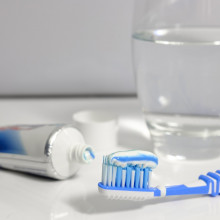
39:55 - Meet the Micro Monsters in your Mouth
Meet the Micro Monsters in your Mouth
with Gordon Ramage, University of Glasgow Dental School
The reason why it’s so important to brush our teeth properly is all to do with the build up of plaque. But what actually is plaque, and why does it matter? Chris Smith spoke to Gordon Ramage from Glasgow Dental School…
Gordon - Plaque is a collection of microorganisms. Bacteria generally, which cooperate with one another, they antagonize one another and they produce slime and that slime sticks them to the teeth.
Chris - So plaque is basically bacterial slime?
Gordon - Yeah and I think the problem is that the general public would think about it as bits of food and I think what we have to do is try and get the message across, is that we have micro monsters in the mouth.
Chris - And what are these microbes actually eating on - are they just dining on what we eat?
Gordon - Yeah absolutely and I think our diet is hugely important, so I think we know an awful lot about things called streptococci and we know that when we eat sugary sweets and other products that they turn that sweet sucrose into slime and that helps them make them even more sticky.
Chris - And what about actually, because people say that you get this acid attack, so you eat some food, this feeds you but it also feeds your mouth microbes and they produce this acid surge. Where does the acid come from?
Gordon - Yeah, so because the bacteria are stuck there and the slime, they start to grow and by growing they produce carbon dioxide and that makes the acidity go even further down, so the pH goes really low. And once that pH goe really low, below below 5.5, then it starts to demineralize the enamel that you talked about earlier. So the bugs are driving the low pH, which then basically starts to erode the enamel and then causes caries and tooth decay.
Chris - How do the bacteria you have in your mouth actually determine your likelihood of getting tooth decay? If you have bacteria that are better at making more acid more of the time, does that mean you're more prone to more tooth decay than someone who doesn't have that?
Gordon - Well I think it really comes down to an individual. So we acquire groups of microorganisms when we are born and somebody for example who breastfeeds versus somebody who is born cesarean, might have a very different oral microbiome, so the types of organisms in our mouth. And we know quite clearly that that's an implication and how you may then go on to progress to dental decay or gingivitis or recession of the gum, bleeding of the gums, depending on the types of organisms you as an individual have will have a real bearing on what you get. Obviously environmental factors like what you eat are going to play a key role.
Chris - What about if you snog someone who has rampant tooth decay, but you don't know that, do you end up picking up their very sort of pro tooth decaying bacterial flora and do you then assimilate that into your mouth microbes and vice versa?
Gordon - Your oral microbiome, or the types of bugs you have the mouth, are dictated to you very early on in your life and as you progress through puberty and so on they'll change. You may acquire the same bugs the same way as if you shook hands with somebody you may acquire bugs to your hand but the likelihood of them staying there long term it's probably not overly likely. So it's quite difficult to acquire them unless you live with someone and their presence for a long time.
Chris - That's reassuring. Now what about actually in the same way that some people like to try to manipulate the bugs that live in their intestines in order to achieve better health, and these are both prebiotic, you eat certain foods that select for better bugs, but you can also take probiotics - you actually ingest certain classes of microorganisms believing that this may change the spectrum of bugs that live in your gut and this will improve your overall health. Can we do the same thing then for oral bacteria? Could we eat certain things or wash our mouths out with a mouthwash with certain suspensions of bacteria that would change the composition of bugs in the mouth and therefore change our risk of getting dental decay or gum disease?
Gordon - I think the concept is absolutely true. I think the ability to manipulate your microorganisms in the mouth with diet, so prebiotics, is probably more likely than probiotics, so giving alive bacteria in your mouth, is going to be very difficult and although there's a number of studies that are sort of suggestive that there are changes in your oral health parameters, they're very limited, so the evidence is pretty poor at this point in time. Not to say that it couldn't happen. There is a potential there.
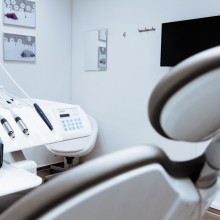
44:28 - Regenerating tooth enamel
Regenerating tooth enamel
with Alvaro Mata, Queen Mary University of London
If we don’t look after our teeth properly, the enamel that protects our teeth breaks down. And once it’s gone, currently, it can never be replaced. But now researchers from Queen Mary University of London may have developed a way around this. They’ve created a protein that works like a scaffold for enamel. It’s just the right shape, and has the correct chemical configuration, to extract from saliva the chemical building blocks of enamel. It then assembles into new enamel in-situ, stitching itself into the native tooth material in the process. So you could squirt it into a prepared tooth cavity and it would grow you a new, tough enamel coating. Alvaro Mata showed Izzie Clarke how...
Alvaro - I took a tooth out today to show it to you!
Izzie- Is that an actual tooth?
Alvaro - This is an actual tooth. It actually has some lesions which is to show you the type of lesions that we would use these material.
Izzie- Gosh there are literally like black holes. And is that what fillings actually looks like.
Alvaro - These are actually fillings. What we are developing is some material that would be implanted instead of these fillings but that would actually look and behave like enamel. So what we are aiming to do is a material that can grow, it can behave as natural enamel and can also integrate with the natural tissue.
Izzie - So, say goodbye to fillings. This works by placing a protein onto the tooth that helps connective tissue and arranges itself into a highly ordered structure. And that's important: enamel is essentially tiny nano-crystals that are locked together, giving it its vital strength. Those developing crystals are then able to capture the calcium and phosphate ions that float around our mouths and keep building and building more crystals until the tooth is repaired. Alvaro lead me over to a giant clear box full of petri dishes and the cavity-ridden teeth in question. At the moment, this all-important process is divided into two stages.
Alvaro - In the first stage in this big, plastic box, what we have is a controlled environment where we can assemble this protein material directly on teeth.
Izzie - And that's to make sure the protein has a fighting start in attaching to the tooth and arranging itself in the most structured way possible.
Alvaro - Then we take that protein material and we immerse it, we put it inside a solution that is recreating the mouth environment, recreates the conditions of saliva.
Izzie - For the second stage, we took the tooth out of the clear box and placed it into a beaker of watery looking solution which mimics the chemistry of our mouths. But, I really hoped that this wasn't someone's actual saliva.
Alcaro - Yes exactly, actually we're doing experiments with actual saliva, which is, yeah! For the moment we're working with a solution that looks like saliva. And so it again it gives us the opportunity to understand how different compositions of that solution can affect the growth of this mineral structure.
Izzie - And so is that just full of, say like, calcium and the phosphates that you need then build up essentially.
Alvar - Correct. And so we have calcium and phosphate ions we have we control the acidity of the environment which is very important. And in general the environment that that is present in the mouth.
Izzie - And how’s it performed, what have you found, are you happy?
Alvaro - Yeah. We have very promising results. So, acid resistance is similar to enamel, its stiffness is not quite that of enamel but we are getting close to it. The material is integrating with the tissue. The crystals are growing within the coding and also inside of the dentine tubules, inside of the natural tissue. So the integration is also an important goal that we are working on.
Izzie - Gosh that looks really promising. So in an ideal world, if that all happens, how would you then go to your local dentist and say “oh you know what, my teeth aren't feeling so good” - how would that work?
Alvaro - Yeah. So what we're hoping is to develop a material that the dentist would be able to apply directly on the tooth of patients in an easy way, just like you go now and there are other material that are being put in our teeth, but in this case it will be a material made out of these proteins. The first challenge is to be able to do it in an easy way that the dentist can do it in a practical fast way directly in the dentist office. The other challenge is to have it stable so that as soon as you deposit it and you implant it, then you can start talking, you can start drinking you can start eating and everything, sort of that active environment of the mouth can take place. But yes so it already shows promising properties.
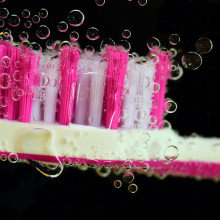
49:02 - Teeth: Quick Fire Questions
Teeth: Quick Fire Questions
with Nick Williams, Devonshire House Dental Practice & Gordon Ramage, University of Glasgow
Chris and Izzie had some quickfire dentistry questions for Nick Williams the dentist and Gordon Ramage from the dental school at the University of Glasgow. First question was for Nick, what exactly is the association between gum disease and heart disease?
Nick - So essentially the plaque bacteria in the mouth can cause inflammation in the gum tissue which then becomes more porous really to the bacteria coming into the body. Your immune system is then trying to fight that off and you’ve essentially got a chronically inflamed state which will then trigger all other inflammatory disorders in the body, which heart disease is one of them. The inflammation the coronary arteries, but also rheumatoid arthritis, dementia, diabetes... There are links to all of these diseases.
Chris - Goodness it's quite far reaching then. And Gordon do we know what microbes are the particular culprits or causative reason why there is this association between poor oral health and heart disease?
Gordon - I think it's more about the functionality of the groups of organisms. If you have more nitrate reducing bacteria, they’re more healthier and depending on the composition of those we can handle nitrates in our diet then that has an implication in terms of overall inflammatory system. And in terms of rheumatoid arthritis, we know absolutely that there's an organism called Porphyromonas gingivalis, a bit like the dinosaurs from earlier really, that we know that produces auto antibodies and that's the driver of rheumatoid arthritis.
Izzie - Oh gosh! Right then, another thing I'd like to know is charcoal toothpaste; this is something that supposedly gives you a dazzling smile. It's the latest craze. Does it actually work?
Nick - Most studies have been done on conventional fluoride toothpastes. The charcoal toothpaste, again, it's getting people to clean their teeth more but a lot of their claims are actually unsubstantiated. So you know go for fluoride toothpaste, the charcoal can be a bit abrasive. it can damage your teeth in fact.
Izzie - Yeah I wondered if it's actually making your teeth whiter because it’s just scratching them down.
Nick - Yeah it can be the case.
Chris - And you raise the question of whitening. How does that work? And is that good or bad?
Nick - Excellent. There was a bit of a wave of popularity of veneers which partly came across in America you know perfect white smile. You see a lot of Americans almost like the piano keys teeth..
Chris - Their teeth are quite frankly whiter than my toilet! Especially celebrities on television. Is that because they've glued stuff on the front of their teeth? That's not their real tooth I'm looking at...
Nick - Absolutely. Now I mean the generic name for them is porcelain. Essentially nowadays we try whitening the teeth with a hydrogen peroxide gel which just releases stains locked into the teeth and encourage people to combine whitening with adult orthodontics. If the teeth are straight too easy to clean, so it's a win win.
Izzie - And what's worse, Nick; sweeties, fruits, crisps? What's the worst thing for our teeth?
Nick - Certainly high sugar options are best avoided. So sweets, certainly carbonated fizzy drinks that have sugar in. There also a few which are considered a healthy choice which can be damaging as well. Dried fruit is a it's one best avoided.
Izzie - Oh, really?
Nick - Yeah. Essentially, the water's been removed from the fruit and it then becomes very sticky and adheres to the teeth and it can stay there for some time.
Izzie - Say parents, for example, your child comes home from school, you give them some dried fruit because you think well that's the best thing for them. So what would be a better alternative to dried fruit?
Nick - Great question. I think certainly fresh fruit or raw carrot batons are a great option. If your child can eat nuts, they're fantastic as well.
Chris - What about flossing? We haven't talked about flossing much. As a dentist once said to me, “You don't have to floss all of your teeth, just the ones you want to keep!”
Nick - Perfect message! It's certainly some that I do. If you're doing it on alternate days, you're going to be removing food to fuel bacteria from between the teeth, which will help with bad breath. It's the contact points of the teeth where you often see a lot of tooth decay starting. So if you're flossing in that region,o certain studies have shown you can reduce tooth decay by 50 percent with that.
Izzie - And when should we be brushing? In the morning, should I brush before or after breakfast.
Nick - Great. If you're having fruit juices breakfast that can soften the enamel. If you brush after that then you can remove some enamel.
Chris - Is that because it's acidic?
Nick - Absolutely. You get erosion then you can brush away the softened tooth structure. But actually, I brush beforehand and then sugar free chewing gum after breakfast is excellent. Removing cereals and things that actually will stick to the teeth. If you're pressed for time getting out of the door you can actually leave that on the teeth so sugar free chewing gum in the car. Perfect.
Izzie - Now Nick if you got a final piece of advice for us?
Nick - I think, Izzie, the thing to remember is tooth decay is preventable. So really avoid those sugary snacks. And if I could go for a second one definitely fluoride toothpaste. Get in there twice a day. And just brush really well.

53:40 - How does one dog breed recognise another?
How does one dog breed recognise another?
Hannah Laeverenz Schlogelhofer put this question to Dr Charlotte Duranton who specialises in dog behaviour, and Professor Donald Broom from Cambridge University...
Charlotte - When you interact with another individual it is essential to be able to identify them, and to know if they belong to your own species or not, so you can adjust your behaviour accordingly. Usually, physical criteria can be used as for most animal species, all individuals are similar in shapes, sizes, proportion, or colour.
But dogs are different. They are the first domesticated species, and have lived in a human environment for at least 15,000 years. During this time we have selected them for different purposes, through artificial selection, which has led to all of the different breeds we know today.
Hannah - So this is how we end up with dogs the shape of sausages meeting dogs that look like bears. But do they recognise each other as the same species?
Charlotte - It is known that dogs use different ways to identify each other as dogs and to communicate together: auditory communication with sounds (such as growls, or barks), chemical communication with odours, and visual communication with for example body position, or face recognition.
Hannah - Smell is the most important of these canine senses. Donald Broom, Professor of Animal Welfare at the Department of Veterinary Medicine at the University of Cambridge, supplied us with this answer...
Donald - When large dogs, such as Great Danes, encounter very small dogs they approach them and sniff them as they would to a larger dog. They must recognise them visually as dogs to approach in the way that they do but the conclusive evidence for being a dog is their smell. Every dog is distinguishable from other species by its characteristic smell and every dog has an odour that allows it to be recognised as an individual. These odours are not dependent on body size, little dogs are treated as dogs, not as small animal prey to chase.
Hannah - Well that’s a relief for the more rabbit sized dogs out there. But this is also important for mating.
Donald - The most obvious test of species identification can be seen if there is a possibility of mating. Bitches on heat respond to approaches by male dogs, whatever the size difference. Big male dogs go through the courtship procedure with small dogs that are on heat and small male dogs show interest in large bitches on heat, even if they can't normally reach to mate. However, the small dogs may show more fear behaviour, if approached by an unfamiliar large dog, than they would to a dog of their own size.










Comments
Add a comment